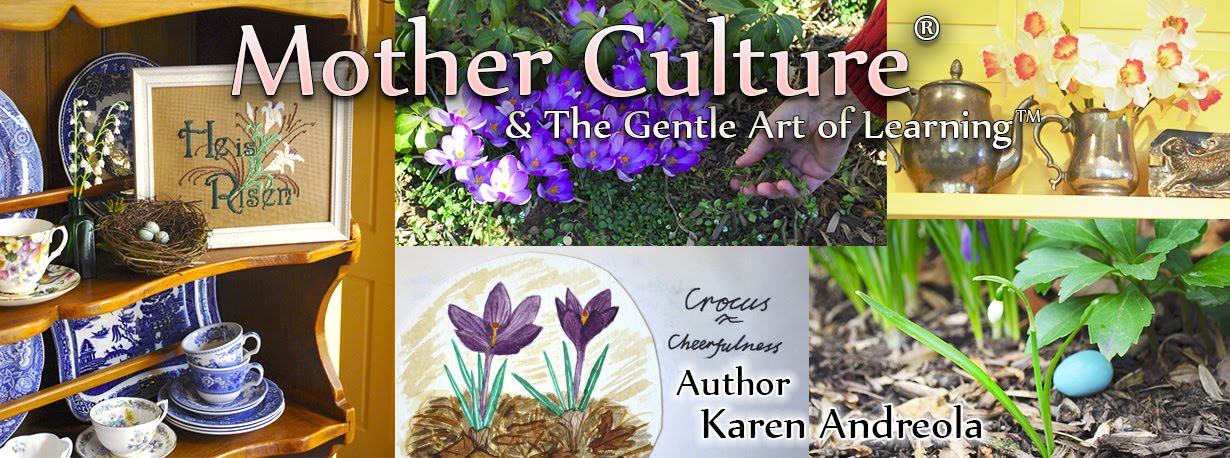Hidden Artist Within
(in appreciation for a lovely lady in-the-Lord)
The finish is wearing off the farm table. It is one of the messiest places in the house, when covered with cutting boards, vegetable scraps, bread four, mixing bowls, or groceries. Just before breakfast I oiled it.
The finish is wearing off the farm table. It is one of the messiest places in the house, when covered with cutting boards, vegetable scraps, bread four, mixing bowls, or groceries. Just before breakfast I oiled it.
I oiled the antique butter press, too, and found a potholder I had sewn
during my first attempts at log cabin patchwork. It felt good to do some
sprucing up.
Breakfast was hot cereal. The Man-of-the-House made a smoothie and left
a few frozen strawberries behind – thawing in a dish. At an impulse his wife
poured them onto a bowl of cereal. Their son appreciated the novelty when it
was served to him.
I was feeling domestically uplifted. You see, the day before I had
turned a few pages in The Hidden Art of Homemaking and that is all it took. On Easter Sunday an
older-woman-in-the-Lord went to be with Jesus. This inspiring lady helped to
shape my life. I never met her in person but I shed a tear for Edith Schaeffer.
Hearing her messages on L’Abri Fellowship tapes and reading some of her
writings satisfied a longing. In those early days I longed to know what a
dedicated Christian woman looked like – that is - what was important to her,
what she thought and felt, how she lived. I sought an example and found one
when I made a book friend of Edith Schaeffer.
In her writings she describes a myriad of ways to love God, love people,
how to serve them and enjoy their company, all-the-while making special the
day-to-day aspects of life. (Hmm, doesn’t this sound something like “the chief
end of man?”) Most interesting of all, Edith Schaeffer expressed her
personality and her art freely within the realm of family and domesticity.
In her book, The Hidden Art of Homemaking Mrs. Schaeffer makes an appeal to the Christian woman who is married
or unmarried. She holds fast to the belief that because a Christian is in
communication with God the Creator, this should lead to an increased capacity
to live creatively. There is no place for humdrum when we are made in our
Creator’s image. We experience greater fulfillment as women and homemakers when
we find and uncover the hidden artist within us.
An unmarried young lady, busy wife, exhausted mother, might not feel
artistic. Mrs. Schaeffer says we become stoical and inhibited by tucking away
the artist within us. Are we safekeeping the effort of artistic expression for
a later or a better time? She challenges and persuades us to express ourselves
in creative ways now, today, wherever we
are living. As we grow in the fruits of the Spirit we also have the wonderful
freedom to grow in creativity. But we have to step forward and give talent a
try.
According to Edith Schaeffer it is a solemn responsibility to be a
homemaker. It requires that we develop our personality and use it to minister
to our husband, children, and in hospitality. Becoming a Christian, a wife and
young mother all within a few short years, I needed someone to open my eyes to
the varied opportunities of serving in the home. Edith Schaeffer provided a
kindly nudge for me to step forward.
In the confusing list of houses our family rented or owned over the
years, I took little steps forward. A handful of bulbs, a few annual flowers
and herbs were planted in containers. If a patch of sunny ground was available
I planted the kind of vegetable - such as zucchini – that an inexperienced
gardener doesn’t need a green thumb to harvest.
I haven’t any particular knack for flower arrangement but Edith
Schaeffer taught me what matters most – flowers are to cheer and to add beauty
– so bring them indoors. Recently I stuffed as many apricot daffodils as would
fit into an empty spice jar. I placed the flowers in a different sort of place
- on the bathroom sink for the Man-of-the-House and me. It was indeed
cheery.
Over the years a sprig of herbs and a few wildflowers came together to
make a bedside bouquet for a sick child or husband. “Are these for me?”
“Yes, dear. I hope you feel better, soon.”
Edith Schaeffer also taught me how to enhance family life and make
togetherness enjoyable. “Happy relationships within a family do not spring up
without someone working at it,” she says, “someone who is not putting himself
or herself first.” We might not consider this to be homemaking until we read
Mrs. Schaeffer’s touching words. Creating a friendly atmosphere of home is homemaking. It is an atmosphere where unrushed time
is taken to build relationships. In her book, examples of drama, music and
other creative recreation, provide alternatives (and stand in contrast) to
today’s enthralling media choices.
One suggestion is to give handwritten notes. Oh, I liked this idea.
Handwritten notes were affectionately given to my children. In time it caught
on. The children began writing notes of their own.
Notes can be left on a pillow, secretly slipped into a suitcase, placed among the schoolwork, laid on a dinner plate, or taped to a door. They say, “You are special to me,” while they are saying thank-you, I’m sorry, get well, wonderful performance, good job, I know this was a sad day for you, or I’ll miss you.” What can take the place of a handwritten note in our modern world – especially one with a drawing?
I cherish the notes to “Mom” that I’ve saved.
Notes can be left on a pillow, secretly slipped into a suitcase, placed among the schoolwork, laid on a dinner plate, or taped to a door. They say, “You are special to me,” while they are saying thank-you, I’m sorry, get well, wonderful performance, good job, I know this was a sad day for you, or I’ll miss you.” What can take the place of a handwritten note in our modern world – especially one with a drawing?
I cherish the notes to “Mom” that I’ve saved.
“We are citizens of a heavenly country and look forward to a home which
is being prepared by God,” says Edith Schaeffer. Meanwhile we can do some
creative feathering of our temporary earthly nest. Among her frugal tips for
interior decorating, it is her invitation to add comfort and color to an
otherwise drab apartment that especially ministered to me when I was feeling
drab myself.
I remember one rented place that was covered in gray-brown wall-to-wall
carpet – the kitchen too. The incident of dropping an egg meant a good amount
of time was spent on hands and knees mopping the gooey spill out of the kitchen
carpet while playful children surrounded me. I remember the temperature in the
kitchen rising and being already frazzled that supper would be far from
punctual. “Don’t cry over spilt milk,” came to mind - to which I added
defiantly, “What if the milk seeps into the carpet?”
Although that kitchen had gray-brown carpet and gray-brown cabinets, it
wasn’t a drab kitchen. The lovely bright sunshine that poured into it prevented
this. The countertop was also unforgettably bright - humorously so – but at the
time I wasn’t laughing. It was kumquat orange - an orange akin
to Fluorescent - and overpoweringly garish.
With Mrs. Schaeffer’s encouragement I made the best of it. Peering
through the window of a charity shop I eyed a pitcher. It was cream porcelain
with bright old-fashioned orange roses.
“It’s got a crack on the handle,” pointed out the Man-of-the-House, who was
trying to sympathize with his wife’s “orange problem.” I had my doubts that he
was thoroughly convinced it was a
significant problem but he put his arm around me and bought it for me, anyway.
That Saturday the antique rose pitcher became a dainty addition to the counter
top - blending in, and softening the color scheme. On some days it held
creamy-white flowers.
“What ever happened to that pitcher?” Dean asked me (20 years later)
after reading the draft of this post.
“I gave it to charity,” I said, “a long time ago.”
He looked puzzled. “I liked that pitcher.”
“Really?” was my curt reply.
The-Man-of-the-House fell silent.
Has your life been touched by Edith Schaeffer’s ministry? I’d be
happy to know if you've also been influenced by The Hidden Art of Homemaking. Are you reserved about leaving a comment? Never mind. You are
cordially welcome to click the inconspicuous word “comments” at the end of the
post to read what others may share here – anytime.
Thank you for visiting,
Karen Andreola
























